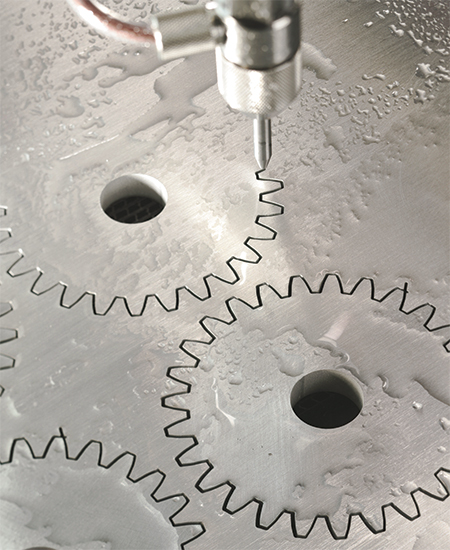Cutting heads offer another example where cutter performance and reliability have improved. Caron and Dumas point to adoption of a diamond centered on the nozzle itself, which has delivered higher tolerances and longer life.
“A diamond can last for 1200 hr. in this application,” says Dumas. “In the past, rubies and sapphires were used, and these lasted anywhere from 5 sec. to 40 hours. They are less expensive, say $15 to $18 for a ruby, but in the long run become much more expensive due to the downtime. If a ruby only lasts for a few seconds and that problem is not caught right away, it will cause problems and the next thing you know, a $200,000 system goes down due to a fragile, inexpensive part. Diamonds offer much more reliability and the industry is moving toward their use.”
Flexibility, Affordability Lead to Increased Use
Waterjet-cutting machines have their place, and increasingly that place has been in fab shops everywhere. Fabricators may cut foam one week and stainless steel the next. The versatile machines have proven that they can switch gears in a hurry and cut whatever is thrown on them. So the machines keep busy, which means more productivity and more dollars for the flexible fabricator.
“On one end you have laser cutters,” explains Caron, “which cut very fast and are ideal for high-tolerance applications, and at the other end you have waterjet cutters, which do not cut as quickly and offer tolerances that are not as tight, though tighter than plasma-cutting machines. But waterjets, as we’ve said, are flexible—able to cut a variety of materials, including thick, hard material.”
Another waterjet-cutting benefit: The process does not impart heat-affected zones, a byproduct of heat-related cutting processes that can result in detrimental physical-property changes to the material. Heat and operating particulars of other processes make them unable to properly cut bonded material or laminates. Waterjet-cutting machines, on the other hand, can handle bonded and laminated material with ease. Brass bonded to stainless steel? Waterjets will cut it, lasers won’t.
As for speed, fabricators can slice cutting time by employing multiple cutting heads.
“Users can add a second cutting head and double production without adding another operator and machine,” says Dumas. “Some machines employ four or even eight heads in the case of cutting foam, for instance, using very small nozzle orifices, so they can cut as quickly as the machine can move.”
Common-line cutting is another speed-assist for waterjet cutting. Because the process creates the same taper on each side of the cut, parts can be nested tightly and two part sides can be processed with a single cut. Plasma cutting and other processes cannot perform such common-line cuts.
Recyclability Can Cut Operating Costs
On top of everything else, waterjet cutting machines have a lower capital-investment cost. Operating costs are lower, too, and with water and abrasive filtering and reclaiming, fabricators have the opportunity to save even more. A typical single-head laser uses about 1 gal. of water per minute, and fabricators employ recycling and filtering to recoup some of that.
Abrasives are one area that still cause some trepidation for fabricators, according to Caron and Dumas.“There is some concern as to the amount of abrasive used and how to recycle it,” Dumas says. “That prevents some fabricators from adopting the technology.”
Toward that end, and because abrasive can surpass 50 percent of the operating cost of a system, Hypertherm has been working on abrasive reclamation. The company is beta testing EcoSift, an abrasive-recycling system that allows users to capture, recycle and reuse spent garnet. Key to recyclability is the fact that, when cutting at pressures of 4000 bar or below, only a portion of the abrasive is pulverized. As much as 60 percent reaches the bottom of the tank without significantly changing shape or size—it can be reused without impacting cut quality. Besides savings related to garnet reclamation, the system can reduce abrasive storage, transport and waste-disposal time and costs.
“We are optimistic that we can recycle close to 50 percent of the used garnet with this system,” says Caron. MF
View Glossary of Metalforming Terms
See also: Hypertherm, Inc.
Technologies: Cutting
Comments
Must be logged in to post a comment. Sign in or Create an Account
There are no comments posted. Cutting
CuttingOmax Launches Mobile Ordering Application
Thursday, June 20, 2024
 Cutting
CuttingFlex Machine Tools Adds New CNC Controls, CAD/CAM Software f...
Monday, April 8, 2024








